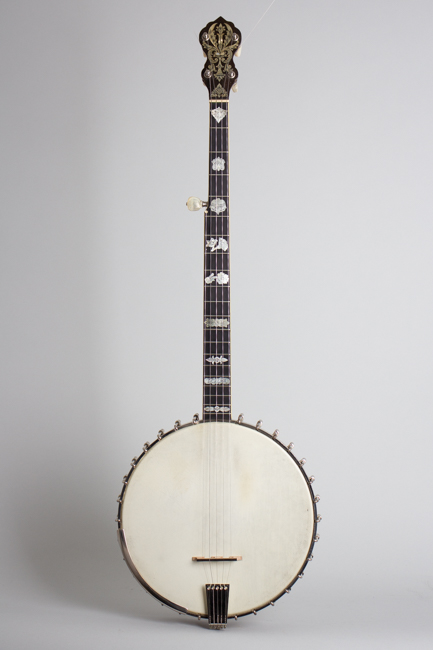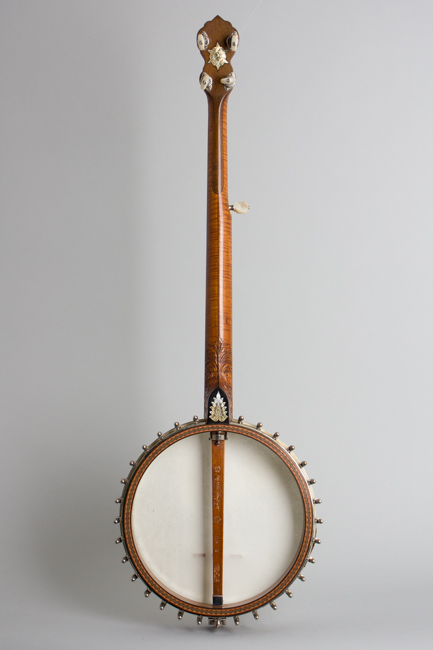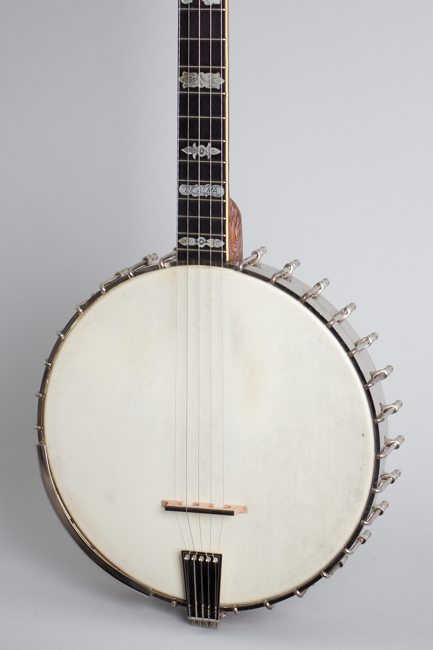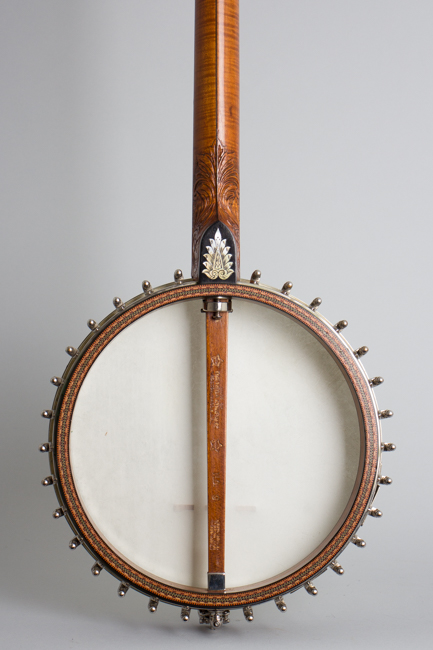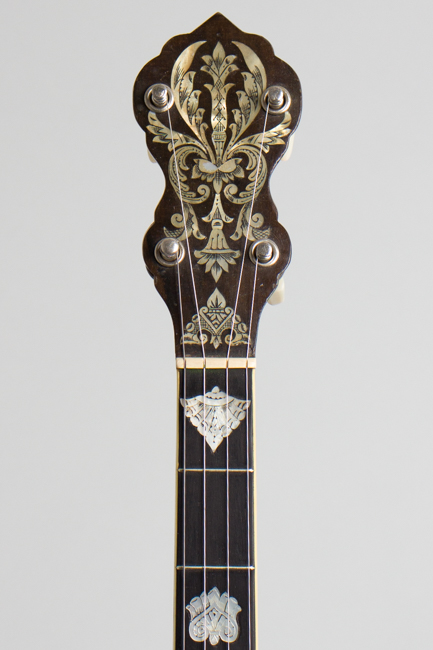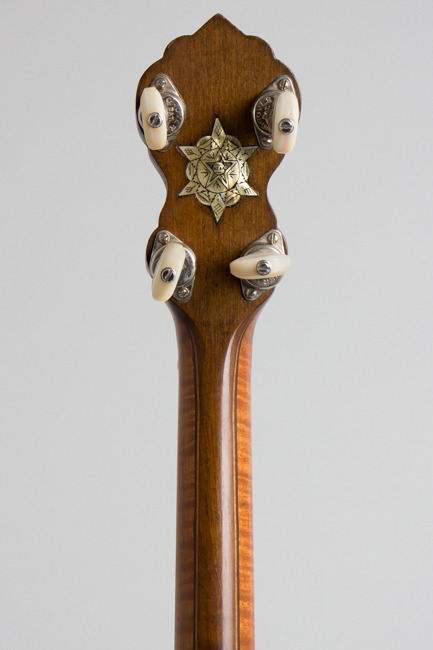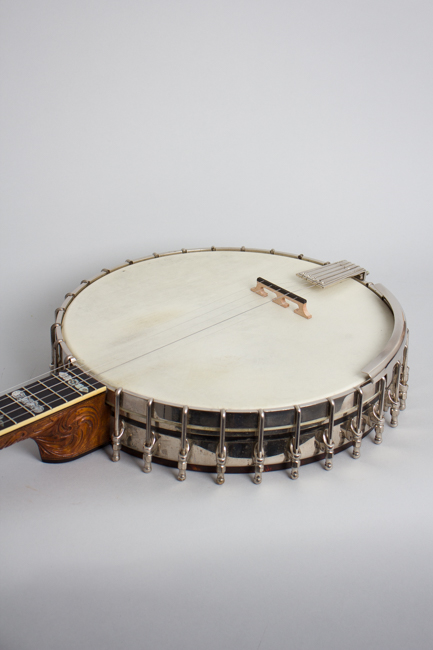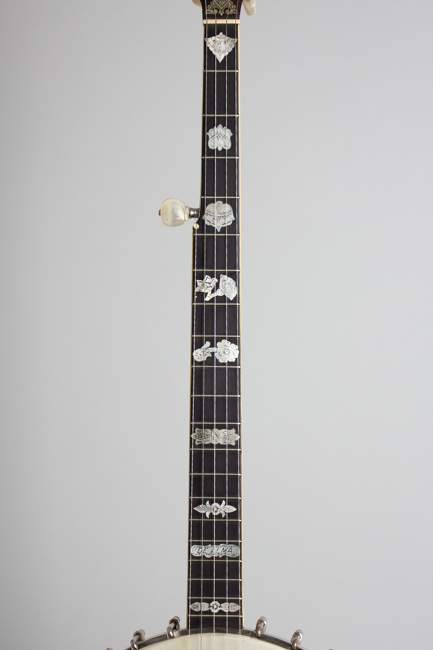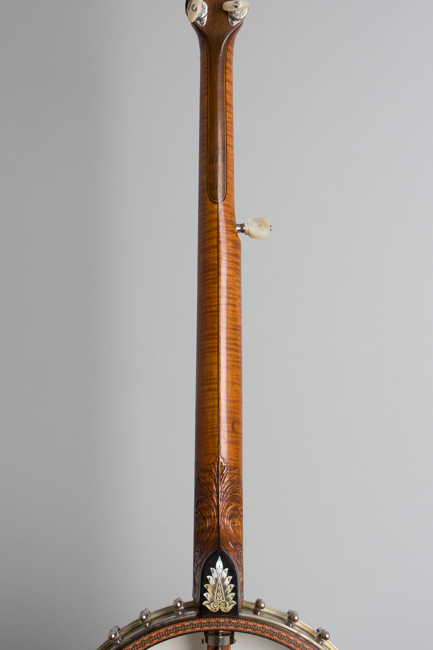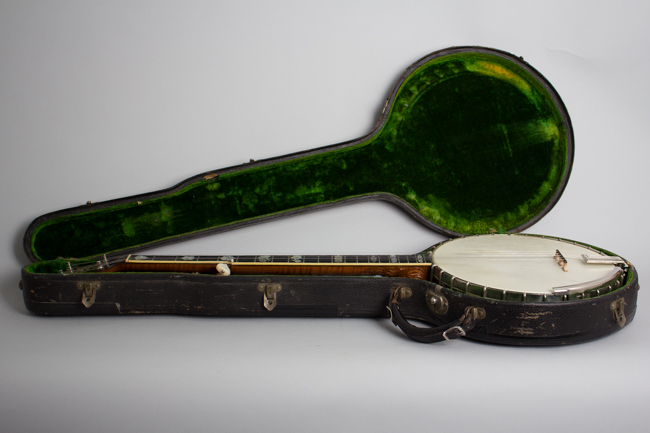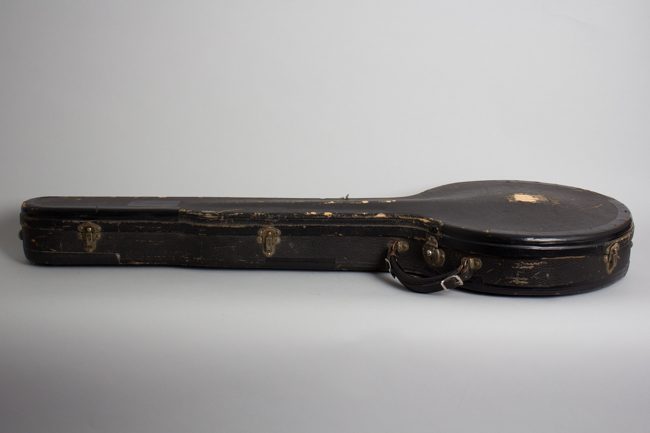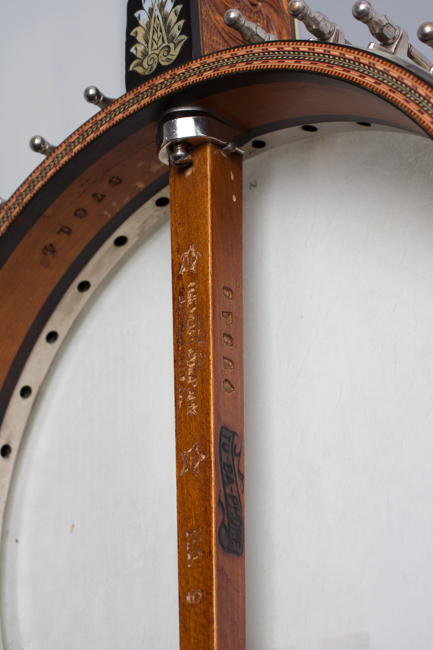Vega Tu-Ba-Phone #9 5 String Banjo (1923)
Vega Tu-Ba-Phone #9 Model 5 String Banjo (1923), made in Boston, Mass., serial # 67614, shaded maple finish, laminated maple neck and rim, ebony fingerboard, original black hard shell case.
This banjo is a truly beautiful example of pretty much the most desired of all openback 5-strings: the Fairbanks/Vega Tu-Ba-Phone #9. While not the absolute pinnacle of the Fairbanks/Vega line, the #9 is generally considered the standard by which any similar instrument is judged; this has been true for well over 100 years! This instrument is built on an 11" diameter rim with a 27" scale neck, pretty much the favored pattern for openback banjos since. Its produces a wonderful sound that few other banjos, new or old, can match. While many builders have emulated these original 100+ year old Fairbanks designs over the last 50+ years, only a few have come close to really matching them.
These world-beating Fairbanks/Vega models were mostly the creations of David L. Day, arguably the most important (if unsung) banjo designer of all time. His innovations set the pattern for what is now the traditional openback banjo and have been widely copied for decades, yet few modern banjo players even know his name. He left Vega in 1922, to Join Fred Bacon in another celebrated banjo company.
This banjo carries "Tu-Ba-Phone" and "No. 9" stamps on the dowel along with a particularly deeply impressed serial number. Depending on which chart one consults it dates between late 1923 and 1926; the features match the 1923 catalog specs and we would lean towards the earlier date. By 1924-5 the great bulk of Vega's efforts went to producing the new "Vegaphone" tenor and plectrum models, with 5-strings rapidly diminishing in popularity. It carries only the "Made by the Vega Company" dowel stamp as use of the older "Fairbanks" name ended in 1922.
By any name this is an exceptionally beautiful banjo, a feast for the eyes as well as the ears! The #9 was the second-highest grade cataloged Vega 5-string, with the rare gold-plated Tu-Ba-Phone Deluxe above it. It features elaborate hand-engraved pearl inlay on the headstock, heelcap and bound fingerboard. The headstock face has an intricate scrolled pearl floral pattern while a "VEGA" logo design ornaments the headstock rear. The heel is elaborately carved in a floral pattern with a pearl-inlaid laminated ebony heelcap. These high-end Vega banjos retain the elaborate Art Nouveau look of the pre-WWI gilded age into the roaring '20s.
The heavy laminate maple rim is equipped with Fairbanks' patented bracket band; the shoes are mounted to that, not drilled through the rim. The rim is capped with the "Tu-Ba-Phone" tone ring that is still a standard fitting today, 115 years since its invention. The bottom of the rim is bound with tortoise celluloid on both edges with elaborate marquetry along the bottom.
The tuners are early Grover Patent geared pegs with genuine pearl buttons; these are period but likely not original to the banjo, although they were probably fitted not more than a couple of years later. Having these correct geared tuners is a great boon to the player; no modern tuner has a thin barrel like these and most of us today would blanch at re-fitting a banjo of this type with anything that required modification. The tailpiece is a 5-string Kersher unique; it appears period but is unmarked, so it may be an old but later issue.
This is an original 1920s 5-string instrument with matching numbers on the dowel and rim; many Tu-Ba-Phones found today are conversions from 4-string. This banjo has the more player friendly geared tuners and remains a wonderful example of one of Fairbanks/Vega's classic banjos with the full measure of that lovely Tu-Ba-Phone sound, the world standard to many old-time players. This is one instrument that instantly justifies its longstanding stellar reputation as one of the finest banjos ever made.
Overall length is 37 in. (94 cm.), 11 in. (27.9 cm.) diameter head, and 2 3/4 in. (7 cm.) in depth, measured at side of rim. Scale length is 27 in. (686 mm.). Width of nut is 1 5/16 in. (33 mm.).
This lovely old banjo has seen some use over the last 100 years or so but appears to have been well cared for through the decades, remaining a superlative instrument. The finish on the neck, rim and dowel is a very thin clear lacquer over shaded maple varnish; this appears original (and typical of the era) but is possible the banjo was lightly overcoated LONG ago. There is not a lot of play wear but some minor dings, dents and rubs here and there.
The hardware is all older, but probably not all absolutely original to the instrument. The hooks and nut set is original and complete, as are the armrest and dowel mounting pieces. The tuners are later 1920's tabbed Grovers that appear to have been added at that time, with what look to be the original pearl buttons from earlier friction tuners. The tailpiece is the correct style Kersher unique, but probably of somewhat later vintage.
The frets are original, and have probably been crowned down just a hair along the way. The inlaid pearl markers are in very nice condition, with the delicate engraving showing very little wear at all. The nut was replaced at some point, as was the 5th string nut, with one railroad spike added at the 7th fret.
This banjo is set up with a very high grade skin head and later bridge; it has a tone that will attract banjoists seeking the absolute best in an openback 5-string, and will continue to do so over the next century. This old #9 rings for days; these rarely turn up in this sort of condition anymore and it's hard to imagine a finer old-time banjo than this, both in look and sound. It includes the original green-lined "bump" HSC, worn but still intact. Overall Excellent - Condition.
This banjo is a truly beautiful example of pretty much the most desired of all openback 5-strings: the Fairbanks/Vega Tu-Ba-Phone #9. While not the absolute pinnacle of the Fairbanks/Vega line, the #9 is generally considered the standard by which any similar instrument is judged; this has been true for well over 100 years! This instrument is built on an 11" diameter rim with a 27" scale neck, pretty much the favored pattern for openback banjos since. Its produces a wonderful sound that few other banjos, new or old, can match. While many builders have emulated these original 100+ year old Fairbanks designs over the last 50+ years, only a few have come close to really matching them.
These world-beating Fairbanks/Vega models were mostly the creations of David L. Day, arguably the most important (if unsung) banjo designer of all time. His innovations set the pattern for what is now the traditional openback banjo and have been widely copied for decades, yet few modern banjo players even know his name. He left Vega in 1922, to Join Fred Bacon in another celebrated banjo company.
This banjo carries "Tu-Ba-Phone" and "No. 9" stamps on the dowel along with a particularly deeply impressed serial number. Depending on which chart one consults it dates between late 1923 and 1926; the features match the 1923 catalog specs and we would lean towards the earlier date. By 1924-5 the great bulk of Vega's efforts went to producing the new "Vegaphone" tenor and plectrum models, with 5-strings rapidly diminishing in popularity. It carries only the "Made by the Vega Company" dowel stamp as use of the older "Fairbanks" name ended in 1922.
By any name this is an exceptionally beautiful banjo, a feast for the eyes as well as the ears! The #9 was the second-highest grade cataloged Vega 5-string, with the rare gold-plated Tu-Ba-Phone Deluxe above it. It features elaborate hand-engraved pearl inlay on the headstock, heelcap and bound fingerboard. The headstock face has an intricate scrolled pearl floral pattern while a "VEGA" logo design ornaments the headstock rear. The heel is elaborately carved in a floral pattern with a pearl-inlaid laminated ebony heelcap. These high-end Vega banjos retain the elaborate Art Nouveau look of the pre-WWI gilded age into the roaring '20s.
The heavy laminate maple rim is equipped with Fairbanks' patented bracket band; the shoes are mounted to that, not drilled through the rim. The rim is capped with the "Tu-Ba-Phone" tone ring that is still a standard fitting today, 115 years since its invention. The bottom of the rim is bound with tortoise celluloid on both edges with elaborate marquetry along the bottom.
The tuners are early Grover Patent geared pegs with genuine pearl buttons; these are period but likely not original to the banjo, although they were probably fitted not more than a couple of years later. Having these correct geared tuners is a great boon to the player; no modern tuner has a thin barrel like these and most of us today would blanch at re-fitting a banjo of this type with anything that required modification. The tailpiece is a 5-string Kersher unique; it appears period but is unmarked, so it may be an old but later issue.
This is an original 1920s 5-string instrument with matching numbers on the dowel and rim; many Tu-Ba-Phones found today are conversions from 4-string. This banjo has the more player friendly geared tuners and remains a wonderful example of one of Fairbanks/Vega's classic banjos with the full measure of that lovely Tu-Ba-Phone sound, the world standard to many old-time players. This is one instrument that instantly justifies its longstanding stellar reputation as one of the finest banjos ever made.
Overall length is 37 in. (94 cm.), 11 in. (27.9 cm.) diameter head, and 2 3/4 in. (7 cm.) in depth, measured at side of rim. Scale length is 27 in. (686 mm.). Width of nut is 1 5/16 in. (33 mm.).
This lovely old banjo has seen some use over the last 100 years or so but appears to have been well cared for through the decades, remaining a superlative instrument. The finish on the neck, rim and dowel is a very thin clear lacquer over shaded maple varnish; this appears original (and typical of the era) but is possible the banjo was lightly overcoated LONG ago. There is not a lot of play wear but some minor dings, dents and rubs here and there.
The hardware is all older, but probably not all absolutely original to the instrument. The hooks and nut set is original and complete, as are the armrest and dowel mounting pieces. The tuners are later 1920's tabbed Grovers that appear to have been added at that time, with what look to be the original pearl buttons from earlier friction tuners. The tailpiece is the correct style Kersher unique, but probably of somewhat later vintage.
The frets are original, and have probably been crowned down just a hair along the way. The inlaid pearl markers are in very nice condition, with the delicate engraving showing very little wear at all. The nut was replaced at some point, as was the 5th string nut, with one railroad spike added at the 7th fret.
This banjo is set up with a very high grade skin head and later bridge; it has a tone that will attract banjoists seeking the absolute best in an openback 5-string, and will continue to do so over the next century. This old #9 rings for days; these rarely turn up in this sort of condition anymore and it's hard to imagine a finer old-time banjo than this, both in look and sound. It includes the original green-lined "bump" HSC, worn but still intact. Overall Excellent - Condition.
